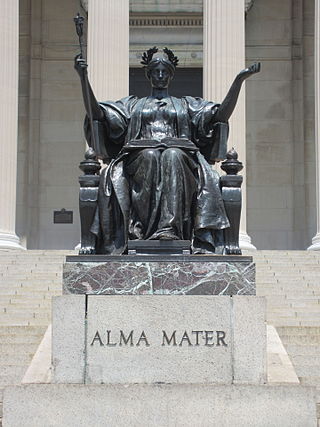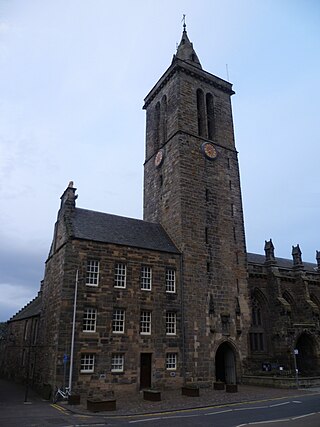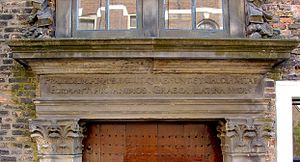
Liberal arts education is the traditional academic course in Western higher education. Liberal arts takes the term art in the sense of a learned skill rather than specifically the fine arts. Liberal arts education can refer to studies in a liberal arts degree course or to a university education more generally. Such a course of study contrasts with those that are principally vocational, professional, or technical, as well as religiously based courses.

Neo-Latin is the style of written Latin used in original literary, scholarly, and scientific works, first in Italy during the Italian Renaissance of the fourteenth and fifteenth centuries, and then across northern Europe after about 1500, as a key feature of the humanist movement. Through comparison with Latin of the Classical period, scholars from Petrarch onwards promoted a standard of Latin closer to that of the ancient Romans, especially in grammar, style, and spelling. The term Neo-Latin was however coined much later, probably in Germany in the late 1700s, as Neulatein, spreading to French and other languages in the nineteenth century.

From the time of Plato through the Middle Ages, the quadrivium was a grouping of four subjects or arts—arithmetic, geometry, music, and astronomy—that formed a second curricular stage following preparatory work in the trivium, consisting of grammar, logic, and rhetoric. Together, the trivium and the quadrivium comprised the seven liberal arts, and formed the basis of a liberal arts education in Western society until gradually displaced as a curricular structure by the studia humanitatis and its later offshoots, beginning with Petrarch in the 14th century. The seven classical arts were considered "thinking skills" and were distinguished from practical arts, such as medicine and architecture.

Rodolphus Agricola was a Dutch humanist of the Northern Low Countries, famous for his knowledge of Latin and Greek. He was an educator, musician, builder of church organs, a poet in Latin and the vernacular, a diplomat, a boxer and a Hebrew scholar towards the end of his life. Today, he is best known as the author of De inventione dialectica, the father of Northern European humanism and a zealous anti-scholastic in the late fifteenth century.

A medieval university was a corporation organized during the Middle Ages for the purposes of higher education. The first Western European institutions generally considered to be universities were established in present-day Italy, including the Kingdoms of Sicily and Naples, and the Kingdoms of England, France, Spain, Portugal, and Scotland between the 11th and 15th centuries for the study of the arts and the higher disciplines of theology, law, and medicine. These universities evolved from much older Christian cathedral schools and monastic schools, and it is difficult to define the exact date when they became true universities, though the lists of studia generalia for higher education in Europe held by the Vatican are a useful guide.

Renaissance humanism was a worldview centered on the nature and importance of humanity, that emerged from the study of Classical antiquity. This first began in Italy and then spread across Western Europe in the 14th, 15th, and 16th centuries. During the period, the term humanist referred to teachers and students of the humanities, known as the studia humanitatis, which included the study of Latin and Ancient Greek literatures, grammar, rhetoric, history, poetry, and moral philosophy. It was not until the 19th century that this began to be called humanism instead of the original humanities, and later by the retronym Renaissance humanism to distinguish it from later humanist developments. During the Renaissance period most humanists were Christians, so their concern was to "purify and renew Christianity", not to do away with it. Their vision was to return ad fontes to the simplicity of the Gospels and of the New Testament, bypassing the complexities of medieval Christian theology.
Humanitas is a Latin noun meaning human nature, civilization, and kindness. It has uses in the Enlightenment, which are discussed below.

Cathedral schools began in the Early Middle Ages as centers of advanced education, some of them ultimately evolving into medieval universities. Throughout the Middle Ages and beyond, they were complemented by the monastic schools. Some of these early cathedral schools, and more recent foundations, continued into modern times.
Of Education is a treatise by John Milton published in 1644, first appearing anonymously as a single eight-page quarto sheet. Presented as a letter, written in response to a request from the Puritan educational reformer Samuel Hartlib, it represents Milton's most comprehensive statement on educational reform, and gives voice to his views "concerning the best and noblest way of education". As outlined in the tractate, education carried for Milton a dual objective: one public, to “fit a man to perform justly, skillfully, and magnanimously all the offices, both private and public, of peace and war” (55); and the other private, to “repair the ruins of our first parents by regaining to know God aright, and out of that knowledge to love Him, to be like Him, as we may the nearest by possessing our soul of true virtue” (52).

Gasparino Barzizza was an Italian grammarian and teacher noted for introducing a new style of epistolary Latin inspired by the works of Cicero.
Byzantine university refers to higher education during the Byzantine Empire.

Niccolò Perotti, also Perotto or Nicolaus Perottus was an Italian humanist and the author of one of the first modern Latin school grammars.

Primary education or elementary education is typically the first stage of formal education, coming after preschool/kindergarten and before secondary school. Primary education takes place in primary schools, elementary schools, or first schools and middle schools, depending on the location. Hence, in the United Kingdom and some other countries, the term primary is used instead of elementary.

Giacomo or Jacopo d'Angelo, better known by his Latin name Jacobus Angelus, was an Italian classical scholar, humanist, and translator of ancient Greek texts during the Renaissance. Named for the village of Scarperia in the Mugello in the Republic of Florence, he traveled to Venice where the Byzantine emperor Manuel II Palaiologos' ambassador Manuel Chrysoloras was teaching Greek, the first scholar to hold such course in medieval Italy.
A Latin mnemonic verse or mnemonic rhyme is a mnemonic device for teaching and remembering Latin grammar. Such mnemonics have been considered by teachers to be an effective technique for schoolchildren to learn the complex rules of Latin accidence and syntax. One of their earliest uses was in the Doctrinale by Alexander of Villedieu written in 1199 as an entire grammar of the language comprising 2,000 lines of doggerel verse. Various Latin mnemonic verses continued to be used in English schools until the 1950s and 1960s.
Abacus school is a term applied to any Italian school or tutorial after the 13th century, whose commerce-directed curriculum placed special emphasis on mathematics, such as algebra, among other subjects. These schools sprang up after the publication of Fibonacci's Book of the Abacus and his introduction of the Hindu–Arabic numeral system. In Fibonacci's viewpoint, this system, originating in India around 400 BCE, and later adopted by the Arabs, was simpler and more practical than using the existing Roman numeric tradition. Italian merchants and traders quickly adopted the structure as a means of producing accountants, clerks, and so on, and subsequently abacus schools for students were established. These were done in many ways: communes could appeal to patrons to support the institution and find masters; religious institutions could finance and oversee the curriculum; independent masters could teach pupils. Unless they were selected for teaching occupations that were salaried, most masters taught students who could pay as this was their main source of income.

A university is an institution of higher education and research which awards academic degrees in several academic disciplines. University is derived from the Latin phrase universitas magistrorum et scholarium, which roughly means "community of teachers and scholars". Universities typically offer both undergraduate and postgraduate programs.

The classical education movement or renewal advocates for a return to a traditional education based on the liberal arts, the canons of classical literature, the fine arts, and the history of civilization. It focuses on human formation and paideia with an early emphasis on music, gymnastics, recitation, imitation, and grammar. Multiple organizations support classical education in charter schools, in independent faith-based schools, and in home education. This movement has inspired several graduate programs and colleges as well as a new peer-reviewed journal, Principia: A Journal of Classical Education.

Education in early modern Scotland includes all forms of education within the modern borders of Scotland, between the end of the Middle Ages in the late fifteenth century and the beginnings of the Enlightenment in the mid-eighteenth century. By the sixteenth century such formal educational institutions as grammar schools, petty schools and sewing schools for girls were established in Scotland, while children of the nobility often studied under private tutors. Scotland had three universities, but the curriculum was limited and Scottish scholars had to go abroad to gain second degrees. These contacts were one of the most important ways in which the new ideas of Humanism were brought into Scottish intellectual life. Humanist concern with education and Latin culminated in the Education Act 1496.

Education in Medieval Scotland includes all forms of education within the modern borders of Scotland, between the departure of the Romans from Britain in the fifth century, until the establishment of the Renaissance late fifteenth century and early sixteenth century. Few sources on Scottish education survived the Medieval era. In the early Middle Ages, Scotland was an oral society, with verbal rather than literary education. Though there are indications of a Gaelic education system similar to that of Ireland, few details are known. The establishment of Christianity from the sixth century brought Latin to Scotland as a scholarly and written language. Monasteries served as major repositories of knowledge and education, often running schools.
















